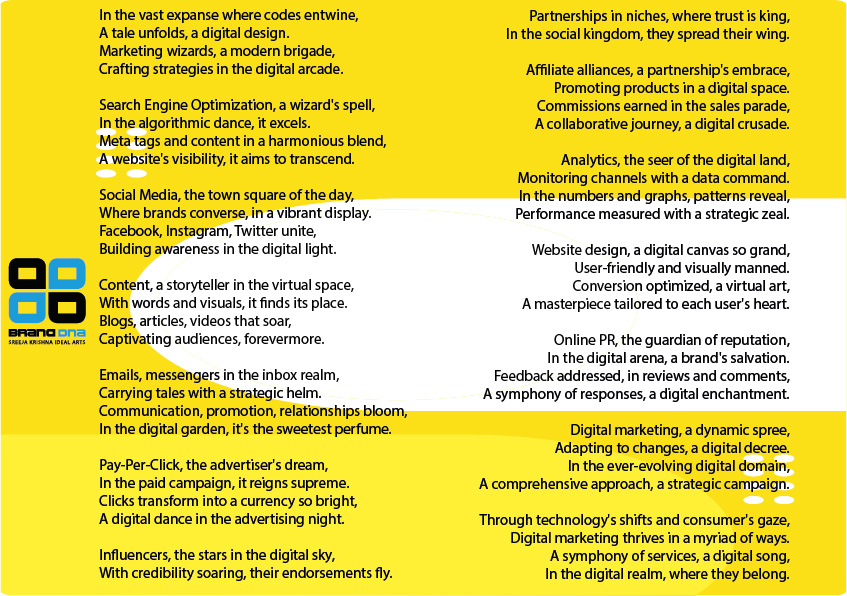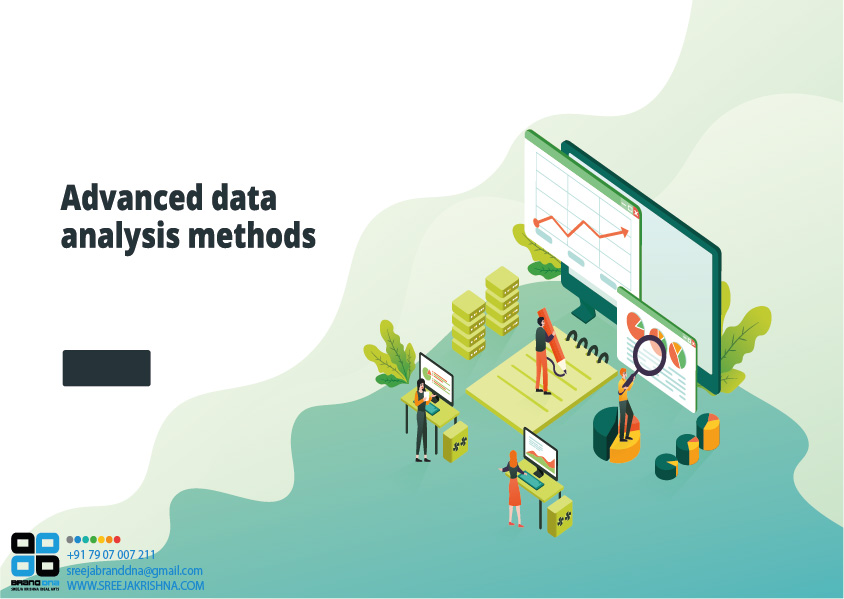“Unleash Your Brand’s Digital Symphony: Where Wizards Weave Tales and Algorithms Dance!”

Digital marketing services encompass a broad range of online strategies and tactics designed to promote products, services, or brands through digital channels. These services leverage the power of the internet and various digital platforms to reach and engage with a target audience. Here are key components of digital marketing services:
In the vast expanse where codes entwine,
A tale unfolds, a digital design.
Marketing wizards, a modern brigade,
Crafting strategies in the digital arcade.
Search Engine Optimization (SEO):

Definition of SEO:
SEO stands for Search Engine Optimization.
It is a practice and set of techniques aimed at optimizing a website.
Objective of SEO:
The primary goal is to enhance a website’s visibility on Search Engine Results Pages (SERPs).
Focus on Organic Traffic:
SEO emphasizes increasing organic (non-paid) traffic to a website.
It differs from paid advertising, aiming to improve natural, unpaid search results.
Optimization Components:
Involves optimizing various elements on a website.
Key components include content, meta tags, and other elements that impact search engine rankings.
Enhancing Content:
Content optimization involves creating high-quality, relevant content.
Content should align with user intent and provide value.
Meta Tags Optimization:
Optimization of meta tags (title tags, meta descriptions) to improve search engine understanding and user click-through rates.
Alignment with Search Algorithms:
SEO strategies align with search engine algorithms (e.g., Google’s algorithm) to ensure favorable rankings.
Keeping up-to-date with algorithm changes is crucial for effective SEO.
Keyword Optimization:
Involves researching and incorporating relevant keywords into content.
Keywords should match user search queries to increase visibility.
User Experience Consideration:
SEO takes into account the overall user experience on a website.
Factors such as page load speed, mobile responsiveness, and user-friendly design contribute to SEO efforts.
Link Building Strategies:
Building high-quality backlinks is an essential part of SEO.
Backlinks from reputable sources can positively impact a website’s authority and ranking.
Measuring and Analyzing Results:
SEO success is measured through metrics like increased organic traffic, higher rankings, and improved visibility.
Analytics tools, such as Google Analytics, help track and analyze the impact of SEO efforts.
Continuous Optimization:
SEO is an ongoing process, requiring continuous monitoring and adjustments.
Regular updates and optimizations are necessary to adapt to changing search engine algorithms and user behaviors.
In summary, SEO is a strategic practice that involves optimizing various elements on a website to enhance its visibility on search engines. The ultimate goal is to increase organic traffic by aligning with search engine algorithms and providing a positive user experience.
Social Media Marketing:

Platform Selection: Choose the appropriate social media platforms based on your target audience and business goals. Common platforms include Facebook, Instagram, Twitter, LinkedIn, etc.
Audience Engagement: Social media marketing is about connecting with your audience. Engage with followers through comments, likes, and shares. Respond promptly to messages and encourage conversation.
Brand Awareness: Utilize social media to increase brand visibility and recognition. Consistent branding across platforms helps in building a strong online presence.
Content Creation: Develop compelling and relevant content to share with your audience. This can include images, videos, articles, and infographics. High-quality and shareable content enhances reach.
Ads and Promotions: Invest in paid advertising to reach a broader audience. Platforms offer various ad formats, targeting options, and analytics to optimize campaigns for better results.
Community Building: Foster a sense of community around your brand. Encourage user-generated content, host giveaways, and create polls or surveys to involve your audience.
Analytics and Metrics: Use analytics tools provided by social media platforms to track performance metrics. Monitor engagement, reach, clicks, and conversion rates to evaluate the effectiveness of your campaigns.
Consistent Posting Schedule: Establish a regular posting schedule to maintain audience interest. Consistency helps build trust and keeps your brand top-of-mind.
Social Listening: Monitor social media for mentions of your brand, industry trends, and competitor activities. This helps in staying informed and adapting your strategy accordingly.
Adaptability: Social media trends and algorithms are constantly evolving. Stay updated on changes, experiment with new features, and adjust your strategy to align with the latest trends.
Targeted Messaging: Tailor your messaging to suit each platform and audience segment. Understand the unique characteristics of each platform and adjust your content and tone accordingly.
Strategic Partnerships: Collaborate with influencers or other businesses to expand your reach. Partnering with relevant entities can provide exposure to new audiences.
By focusing on these key points, businesses can effectively leverage social media platforms for marketing purposes, fostering meaningful connections and achieving their objectives.
Content Marketing:

Content Marketing Overview:
Content marketing is a strategic approach that involves the creation and distribution of valuable, relevant, and consistent content to attract and retain a clearly defined audience. This content can take various forms, including blog posts, articles, videos, infographics, podcasts, and more. The primary goal of content marketing is to provide valuable information to the audience, thereby building trust, establishing authority in the industry, and ultimately driving customer loyalty and engagement.
Audience-Centric Approach: Focus on understanding the needs, interests, and pain points of your target audience. Tailor content to address their specific challenges and provide solutions.
Quality Over Quantity: Prioritize the quality of your content. Well-researched, informative, and engaging content is more likely to resonate with your audience and establish your brand as a reliable source of information.
Consistency is Key: Maintain a consistent publishing schedule. Regularly share new content to keep your audience engaged and demonstrate your commitment to providing ongoing value.
Multichannel Distribution: Distribute content across various channels, such as your website, social media platforms, email newsletters, and third-party publications. This ensures a wider reach and increases the likelihood of reaching your target audience.
SEO Integration: Optimize content for search engines to enhance discoverability. Use relevant keywords, meta tags, and descriptive titles to improve search engine rankings and attract organic traffic.
Storytelling: Incorporate storytelling into your content to make it more relatable and memorable. Narratives help create an emotional connection with your audience, making your brand more memorable.
Authority Building: Position your brand as an industry authority by providing in-depth and insightful content. This can include research studies, expert interviews, and thought leadership pieces.
Call-to-Action (CTA): Include clear and compelling calls-to-action in your content to guide your audience toward desired actions, whether it’s signing up for a newsletter, downloading a resource, or making a purchase.
Analytics and Iteration: Regularly analyze performance metrics such as engagement, click-through rates, and conversions. Use this data to refine your content strategy and optimize for better results over time.
Adaptability: Stay abreast of industry trends and changes in audience preferences. Be willing to adapt your content strategy to meet evolving needs and preferences.
By focusing on these key points, businesses can leverage content marketing to build a loyal audience, enhance brand reputation, and drive meaningful engagement with their target market.
Email Marketing:

Here are key points about email marketing:
Definition: Email marketing involves sending targeted messages to a group of people via email.
Purpose: It serves multiple purposes, including communication, promotion, and building relationships with customers.
Communication Tool: Email marketing is an effective communication tool for businesses to interact with their audience, providing updates, news, and relevant information.
Promotion: Businesses use email marketing to promote products, services, or special offers directly to their audience’s inbox.
Customer Relationship Building: Email marketing helps in building and nurturing relationships with customers by providing valuable content, personalized recommendations, and engaging with their feedback.
Newsletter Distribution: Newsletters are a common form of email marketing, sharing periodic updates, industry insights, and company news with subscribers.
Promotional Emails: Businesses send promotional emails to showcase new products, announce sales, or provide exclusive discounts to encourage purchases.
Personalization: Effective email marketing often involves personalized content tailored to the interests and preferences of individual recipients, enhancing engagement.
Segmentation: Marketers often segment their email lists based on demographics, behaviors, or preferences, allowing for more targeted and relevant messaging.
Analytics and Tracking: Email marketing platforms provide analytics tools to track the performance of campaigns, including open rates, click-through rates, and conversions, enabling marketers to assess and improve their strategies.
Automation: Many email marketing campaigns use automation to send predefined sequences of emails based on user actions, making the process more efficient and timely.
Compliance: Adherence to email marketing regulations, such as obtaining consent and providing opt-out options, is crucial to maintain legal compliance and build trust with recipients.
In summary, email marketing is a versatile tool that businesses use to communicate, promote, and foster relationships with their audience, employing strategies like personalization, segmentation, and automation for effective results.
Pay-Per-Click (PPC) Advertising:

Definition: PPC advertising involves running paid campaigns where advertisers pay a fee each time their ad is clicked by a user.
Payment Model: Advertisers are charged only when a user clicks on their ad, not for the ad placement itself. This model is cost-effective for businesses as they pay for actual user engagement.
Common Platforms: Google Ads and Bing Ads are popular PPC platforms where advertisers bid on keywords to have their ads displayed in relevant search results and websites.
Targeted Advertising: PPC allows for highly targeted advertising based on specific keywords, demographics, locations, and other parameters, ensuring ads reach a relevant audience.
Keyword Bidding: Advertisers bid on keywords relevant to their products or services. The ad placement is determined by a combination of the bid amount and the ad’s quality score.
Ad Rank: Advertisements are ranked based on factors like bid amount, ad quality, and the expected impact of ad extensions. Higher-ranked ads are more likely to be displayed prominently.
Ad Formats: PPC ads can take various formats, including text ads, display ads, and shopping ads, providing flexibility in how advertisers present their content.
Budget Control: Advertisers have control over their budget, setting daily or campaign budgets to manage costs effectively.
Ad Copy and Creatives: Creating compelling ad copy and visuals is crucial for attracting clicks and driving conversions. Advertisers aim to create engaging content that encourages users to take desired actions.
Conversion Tracking: PPC platforms provide tools for tracking conversions, allowing advertisers to measure the success of their campaigns and make data-driven optimizations.
Real-Time Adjustments: Advertisers can make real-time adjustments to their PPC campaigns, such as modifying bids, changing ad creatives, or adjusting targeting parameters based on performance metrics.
Competitive Landscape: Advertisers compete for ad placements through auctions, where factors like bid amount and ad quality influence the likelihood of winning the auction and having the ad displayed.
In summary, PPC advertising is a paid advertising model where businesses pay for each click on their ads. It offers targeted advertising options, flexibility in ad formats, and real-time adjustments, making it a dynamic and measurable method for online marketing.
Influencer Marketing:

Definition: Influencer marketing involves collaborating with influential individuals in a specific niche to promote a product or service.
Partnership: Brands partner with influencers who have established credibility and a significant following on social media platforms.
Credibility and Trust: Influencers build trust with their audience, and their recommendations are often seen as more authentic compared to traditional advertising.
Niche Expertise: Influencers typically specialize in a particular niche or industry, allowing brands to target specific audiences that align with their products or services.
Social Media Platforms: Influencers often operate on popular social media platforms such as Instagram, YouTube, Twitter, TikTok, and others, leveraging their reach and engagement.
Types of Influencers: Influencers can be categorized based on their follower count: nano-influencers (small following), micro-influencers (moderate following), macro-influencers (large following), and mega-influencers (celebrities with massive followings).
Authenticity: Authenticity is key in influencer marketing. Influencers are effective when they maintain a genuine connection with their audience and authentically integrate brand endorsements into their content.
Content Creation: Influencers create content that showcases the brand or product in a way that resonates with their audience, whether through photos, videos, reviews, or other creative formats.
Engagement Metrics: Brands assess influencer marketing success through metrics like engagement rates, likes, shares, comments, and, when applicable, the impact on sales or conversions.
Compensation Models: Influencers may be compensated through various models, including flat fees, performance-based incentives, free products, or a combination of these.
Campaign Goals: Influencer marketing campaigns can have different goals, such as brand awareness, product launches, driving website traffic, or generating sales.
Regulatory Compliance: Adherence to regulatory guidelines and disclosure requirements is crucial in influencer marketing, ensuring transparency about paid partnerships.
Long-term Relationships: Building long-term relationships with influencers can lead to ongoing collaborations, providing consistency and familiarity with the brand among the influencer’s audience.
In summary, influencer marketing leverages the credibility and reach of influential individuals to promote products or services authentically. The success of influencer campaigns relies on selecting the right influencers, maintaining authenticity, and aligning with the goals of the brand.
Affiliate Marketing:

Definition: Affiliate marketing involves establishing partnerships with individuals or other businesses (affiliates) who promote your products or services in exchange for a commission on sales generated through their efforts.
Partnership Structure: Affiliates earn a commission for each sale, lead, or desired action that results from their promotional activities.
Performance-Based: Affiliate marketing is performance-based, meaning affiliates are compensated based on the actual results they deliver, such as sales or conversions.
Affiliate Networks: Businesses often use affiliate networks, which act as intermediaries connecting advertisers (businesses) with affiliates. These networks manage tracking, payments, and reporting.
Promotional Channels: Affiliates can promote products through various channels, including websites, blogs, social media, email marketing, and other online platforms.
Commission Models: Different commission models exist, including a percentage of the sale, a fixed amount per sale or lead, or a combination of these. Commission rates may vary based on the type of product or service.
Tracking and Analytics: Robust tracking systems are used to monitor affiliate activities and attribute sales or conversions to the appropriate affiliates. Analytics help assess the performance of the affiliate marketing program.
Creatives and Marketing Materials: Advertisers provide affiliates with creatives, such as banners, text links, and promotional materials, to assist in their marketing efforts.
Cookie Tracking: Cookies are often used to track users who click on affiliate links, allowing for accurate attribution of sales to the respective affiliates.
Global Reach: Affiliate marketing enables businesses to reach a global audience as affiliates can promote products to audiences worldwide.
Cost-Effective: For businesses, affiliate marketing can be a cost-effective marketing strategy as expenses are tied directly to actual sales or leads.
Recruitment and Relationship Management: Successful affiliate programs involve recruiting and managing relationships with affiliates effectively. Communication and support are essential for a thriving partnership.
Regulatory Compliance: Adherence to regulations and ethical practices, including transparent disclosure of affiliate relationships, is crucial in affiliate marketing.
Incentives: Offering incentives, such as bonuses or increased commission rates for high-performing affiliates, can motivate affiliates to actively promote products.
In summary, affiliate marketing is a performance-based marketing strategy where businesses collaborate with affiliates to promote products or services in exchange for a commission. It’s a scalable and cost-effective way to expand reach and drive sales.
Analytics and Data Analysis:

Here are key points about Analytics and Data Analysis in the context of digital marketing:
Definition: Analytics and data analysis involve the systematic examination of data collected from various digital marketing channels to measure performance and derive insights for informed decision-making.
Digital Marketing Channels: Data is collected from diverse digital marketing channels, including websites, social media, email campaigns, search engines, and online advertising.
Performance Measurement: Analytics tools help measure the effectiveness of marketing campaigns by tracking key performance indicators (KPIs) such as traffic, conversions, click-through rates, and engagement.
User Behavior Tracking: Understanding user behavior is crucial. Analytics provides insights into how users interact with digital assets, revealing patterns, preferences, and areas for improvement.
Google Analytics: Google Analytics is a widely used analytics platform that provides detailed information about website traffic, user demographics, and user interactions. It allows for customized reporting and analysis.
Data Integration: Combining data from various sources allows for a holistic view of marketing performance. Integration with Customer Relationship Management (CRM) systems and other tools enhances data accuracy and completeness.
Conversion Tracking: Analytics tools enable the tracking of conversion events, such as completed purchases, form submissions, or other desired actions, helping assess the success of marketing efforts.
Segmentation: Data analysis often involves segmenting audiences based on demographics, behavior, or other criteria. This segmentation provides targeted insights for more personalized marketing strategies.
Real-Time Monitoring: Some analytics tools provide real-time data, allowing marketers to monitor and respond promptly to changing trends or issues.
A/B Testing: A/B testing, or split testing, is a common practice in data analysis where variations of a marketing element are compared to determine which performs better in achieving the desired outcome.
ROI Measurement: Analytics helps calculate the return on investment (ROI) for marketing campaigns, providing insights into the cost-effectiveness of various strategies.
Data Visualization: Visualization tools turn raw data into graphs, charts, and dashboards, making complex information more accessible and facilitating easier interpretation.
Predictive Analytics: Advanced analytics techniques, including predictive analytics, use historical data to forecast future trends and make proactive marketing decisions.
Privacy and Compliance: Marketers must adhere to data privacy regulations and implement measures to ensure the ethical and legal use of data.
In summary, analytics and data analysis in digital marketing involve the systematic examination of data from various channels to measure performance, understand user behavior, and make informed, data-driven decisions for optimizing marketing strategies.
Website Design and Development:

Here are key points about Website Design and Development in the context of supporting digital marketing efforts:
User-Friendly Design: The primary goal is to create a website that is intuitive and easy to navigate, providing a positive user experience for visitors.
Visual Appeal: A visually appealing design enhances the overall impression of the website and reinforces the brand identity. Consistent branding elements contribute to a cohesive user experience.
Responsive Design: Websites should be designed to be responsive, ensuring a seamless and consistent experience across various devices, including desktops, tablets, and mobile phones.
Optimized for Conversions: Conversion optimization involves designing the website to encourage desired actions, such as making a purchase, filling out a form, or subscribing to a newsletter.
Clear Call-to-Action (CTA): Well-defined and strategically placed CTAs guide visitors on what actions to take next, improving the chances of conversion.
Fast Loading Times: Optimizing website performance, including fast loading times, is crucial for retaining visitor interest and positively impacting search engine rankings.
Search Engine Optimization (SEO): Incorporating SEO best practices during website development helps improve visibility on search engines, making it easier for potential customers to find the site.
Content Management System (CMS): Implementing a user-friendly CMS allows businesses to easily update and manage website content without requiring extensive technical knowledge.
Security Measures: Website security is paramount. Implementing SSL certificates, regular updates, and security protocols ensures a safe browsing experience for visitors.
Integration with Analytics: Connecting the website to analytics tools, such as Google Analytics, allows for the monitoring of user behavior, traffic, and other key metrics.
Social Media Integration: Integrating social media elements and sharing buttons enables visitors to easily engage with and share website content on various social platforms.
Scalability: The website design should be scalable to accommodate future growth, additional features, and evolving business needs.
Brand Consistency: Ensuring consistency in branding elements, such as colors, logos, and messaging, creates a unified and memorable brand identity.
Accessibility: Designing the website with accessibility in mind ensures that it is usable by individuals with disabilities, enhancing inclusivity.
Cross-Browser Compatibility: Testing and optimizing the website for compatibility across different web browsers ensure a consistent experience for users regardless of their browser choice.
Feedback and Usability Testing: Gathering feedback and conducting usability testing during the development process helps identify areas for improvement and ensures a positive user experience.
In summary, website design and development play a critical role in creating a user-friendly, visually appealing, and conversion-optimized online presence. A well-designed website supports digital marketing efforts by providing a strong foundation for engaging visitors and achieving business objectives.
Online Public Relations (PR):

Here are key points about Online Public Relations (PR):
Definition: Online Public Relations (PR) involves managing a brand’s reputation and public image through various digital channels.
Reputation Management: Online PR focuses on maintaining and enhancing the brand’s reputation in the digital space by monitoring online conversations and addressing potential issues.
Digital Channels: Online PR activities occur across various digital platforms, including social media, review sites, forums, blogs, and news websites.
Proactive Communication: Brands engage in proactive communication to build positive relationships with their audience, industry influencers, and the media.
Crisis Management: Online PR strategies include preparedness for and management of crises, addressing negative publicity or addressing issues promptly and transparently.
Social Media Monitoring: Monitoring social media platforms for brand mentions, comments, and conversations helps identify trends and sentiments, allowing for timely responses.
Response Strategies: Establishing guidelines and strategies for responding to positive and negative feedback, reviews, and comments helps maintain a constructive online presence.
Brand Advocacy: Cultivating brand advocates and influencers who can positively impact public perception and contribute to positive word-of-mouth.
Transparency and Authenticity: Online PR emphasizes the importance of transparent and authentic communication to build trust with the audience.
Media Relations: Building relationships with digital media outlets and influencers to secure positive coverage and manage the dissemination of news and information.
Online Press Releases: Distributing press releases through online channels to share important announcements, updates, or positive news about the brand.
Monitoring Trends and Topics: Staying informed about industry trends, relevant topics, and public sentiment to align communication strategies accordingly.
Community Engagement: Engaging with online communities and participating in discussions to establish the brand as an active and positive member of the digital ecosystem.
Feedback Utilization: Utilizing feedback from online channels to inform business decisions, improve products or services, and demonstrate responsiveness to customer concerns.
Employee Advocacy: Encouraging employees to be advocates for the brand online and providing guidelines for responsible and positive representation.
Measurement and Analysis: Using analytics tools to measure the impact of online PR efforts, track sentiment, and assess the effectiveness of strategies over time.
Legal and Ethical Considerations: Ensuring compliance with legal requirements and ethical standards in online communications to avoid reputational risks.
In summary, Online Public Relations involves actively managing a brand’s online reputation, engaging with the digital audience, and strategically addressing feedback, reviews, and comments to maintain a positive public image in the digital space.
Digital marketing services are dynamic and ever-evolving, adapting to changes in technology, consumer behavior, and the digital landscape. The combination of these services forms a comprehensive approach to building a strong online presence, engaging with the target audience, and achieving marketing objectives in the digital space.

